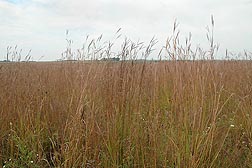Can a Prairie Teach Us About Agricultural Water Quality?
One place to figure out how agricultural practices affect water quality is in a crop field that is being converted to native prairie vegetation. In Iowa, natural resource managers are conducting this type of landscape restoration at the Neal Smith National Wildlife Refuge near Prairie City. So this is where Agricultural Research Service soil scientists Mark Tomer and Cynthia Cambardella partnered with colleagues from Grinnell College, the U.S. Fish and Wildlife Service, and the Iowa Geological Survey Bureau (part of the Iowa Department of Natural Resources) to describe changes in water quality during prairie establishment.
The ARS researchers work at the National Laboratory for Agriculture and the Environment in Ames. Their group studied concentrations of nitrates and phosphorus in ground water in a 17-acre field while it was being converted from corn and soybean row-cropping to a reconstructed prairie. The researchers set up ground-water monitoring wells and collected water samples from 2002 through 2009.
After a final soybean harvest in 2003, the field was seeded with native grasses and forbs. As the prairie became established, nitrate concentrations declined and stabilized within 5 years. Initially, nitrate levels in ground-water wells higher up the slopes averaged 10.6 parts per million (ppm), levels that can fuel downstream development of the “dead zone” in the Gulf of Mexico.
But nitrate levels along ephemeral waterways averaged only 2.5 ppm, and after 2006, nitrates disappeared from the shallow ground water near the waterways. Further upslope, ground water still had measurable nitrate levels in 2006, but levels diminished to around 2 ppm after 2007.
“The rate of nitrate loss mostly came down to two things: how much available carbon was in the soil and the depth of the water table,” Tomer notes. “Along the waterways, there was carbon available in the saturated soils. This provided an environment promoting denitrification that can decrease nitrate concentrations fairly rapidly—within one growing season. Upland soils were drier and had less available carbon, so nitrate loss occurred more slowly.”
These results didn’t surprise the researchers. But phosphorus measurements did, because unlike nitrate, phosphorus levels did not decline. Between 2006 and 2009, phosphorus concentrations averaged 0.14 ppm along the ephemeral waterways, while average upland concentrations were only around 0.02 ppm. The higher phosphorus concentrations were found in shallow ground water along the waterways—and if ground-water levels rose enough to produce overland flows that contribute to streamflow, the phosphorus concentrations were high enough to threaten local water quality.
“We learned that while conservation practices that plant grass along waterways and in riparian buffers can trap sediments from field runoff, the sediments contain phosphorus that can leach into the water,” Tomer says. “Under certain conditions, legacy nutrients in soil might still pollute nearby waterways, even though eroded soil has been trapped.” Legacy nutrients remain in the soil long after producers have stopped using them to fertilize crops.
Tomer wants to learn more about this tradeoff between phosphorus and nitrate in shallow ground water, how often it occurs, and what controls it. “We think studying this prairie has given us insight that can help farmers better manage water quality, from their fields right down to the Gulf of Mexico.”—By Ann Perry, Agricultural Research Service Information Staff.
This research is part of Water Availability and Watershed Management (#211) an ARS national program described at www.nps.ars.usda.gov.
To reach the scientists mentioned in this article, contact Ann Perry, USDA-ARS Information Staff, 5601 Sunnyside Ave., Beltsville, MD 20705-5129; (301) 504-1628.
"Can a Prairie Teach Us About Agricultural Water Quality?" was published in the February 2012 issue of Agricultural Research magazine.







